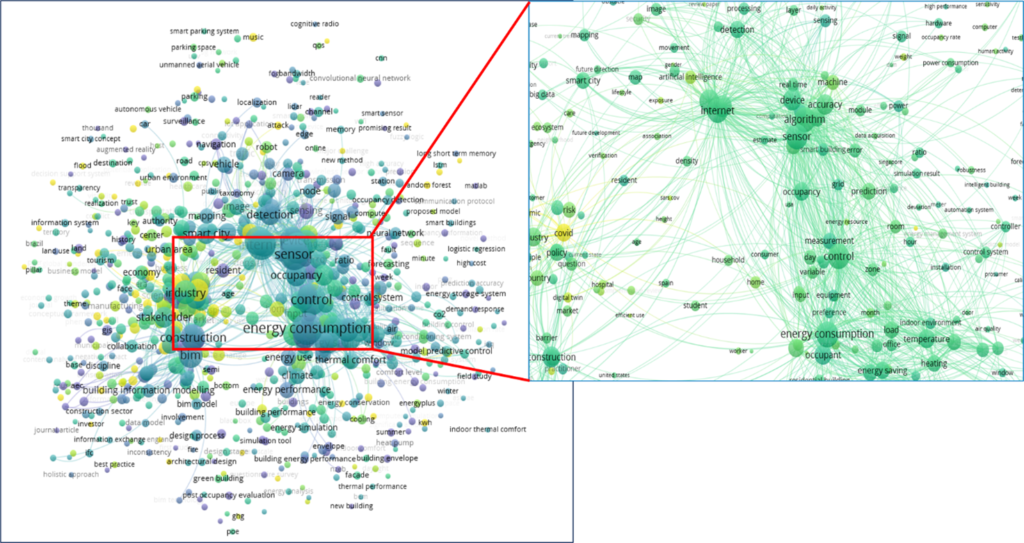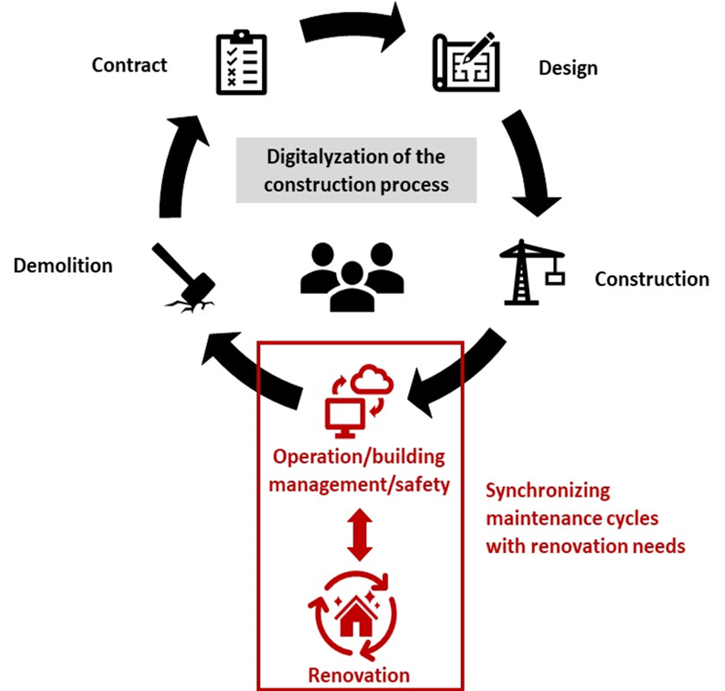Data in and for building stock management
Predictive approaches, based on occupancy data integrated into a common digital framework, can improve building stock management by supporting the correct allocation of technical and economic resources during the actual operation of buildings. In fact, occupancy impacts every aspect of the life of a building (i.e., energy consumption, maintenance costs, safety management). Nevertheless, occupancy data collected during the operation of buildings through automated systems such as BAS (building automation systems) and CMMS (computer maintenance management systems) are rarely used to improve building management, whose costs can reach up to 75% of the initial construction cost.
The DIGITMAN approach
The EU recently proposed a whole life-cycle digital logbook for buildings as a digital repository supporting building management tasks. However, integrating dynamic occupancy data into this type of digital repository and using these data to predict the impact of alternative strategies are relatively unexplored fields. Moreover, a common digital framework for building management, based on common languages/interfaces/data matching methods, is still lacking, as underlined by the EU.

The proposed predictive approach will be based on a set of analytic methods (e.g., ML, MAS) applied to the main pillars of building management (operation, maintenance, safety) and multicriteria approaches, thanks also to the availability of experimental data from 30 buildings managed by three local public authorities.
The framework and database will be defined by focusing on the main aims of the project, which are (i) optimizing the economic resource allocation, (ii) increasing indoor comfort and well-being, and (iii) setting a long-time renovation roadmap.” The general issues will be directly focused on chosen pilots, which are representative of the complexity of building stocks managed by private or public bodies. Pilots will both provide stored (but still unused) historical data and allow the additional collection of new data. Measurements will be performed during the project, and data will be collected from CMMS and BAS to improve and further validate the proposed approach for data collection, structuring, and analysis. In this way, DIGITMAN, strictly related to a set of EU strategies (e.g., A digital future for Europe, Next-generation EU plan) and the Italian PNNR, will have a particular impact on the digitalization of the Italian public sector, considering that about 10% of the total Italian building stock is managed by public authorities.
Essential background
While most buildings are designed for occupants, with the functions of providing comfortable, healthy, usable and secure spaces, human-building interaction remains one of the least mature fields of building science [1,2]. However, a Scientometrics analysis shows a growing interest in the field due to the growing availability of methods and devices to acquire information about occupants’ behaviour. They can support the implementation of predictive approaches to improve operation, maintenance and safety as the three pillars of building management and human-building interaction.

A recent review on building management [3] shows, also, how the research community should be involved to improve these processes. Three topics, relying on digital approaches, are proposed: (i) AI-supported building management procedures for fault detection, diagnostic and predictive control; (ii) data extraction and visualization support to transform stored data into information to optimize processes; (iii) advanced occupants’ feedback and behaviour-based technologies. Gunay et al. [4] developed a review to identify the state of data analytics for improving building O&M, showing that existing untapped or underutilized data sources, e.g. CMMS, can be of great utility to optimize the building management process. For instance, Zhao et al. [5] developed a conceptual framework to apply digital twin technologies and use information stored in CMMSs and BMSs for building management improvement. The authors organized a framework (Figure 2) showing how data about occupants’ behaviour collected during the operation of buildings (e.g., BAS, CMMS) can support the development of AI-based functions to introduce predictive management approaches.
Introducing AI into building management procedures has been discussed also by Molina-Solana et al. [6]. Predictive management approaches need the support of deep knowledge of occupants’ behaviour and the acquisition of dynamic occupant data [1,7]. The EU [4,8–10] recently published guidelines to foster the introduction of a tool for building management digitalization [11], supporting also the creation of a common European framework [12–14].
Only by acknowledging the occupancy dynamic data (i.e., occupants’ movement, activities and use of the spaces over time, dynamic energy and maintenance needs, safety procedures), it is possible to predict the impact of alternative strategies, define a clear renovation roadmap and correctly allocate economic and technical resources. Occupancy dynamic data, collected through BMSs integrated with new technologies (i.e., real-time use, sensors), and also through CMMSs, could be analysed by text mining [3,15] and machine learning methods [16–18] and used as the basis to predict the impact of future scenarios. However, it is important to underline that the biggest owners of building stocks in almost all State Members are public authorities [8]. Around 10% of the whole Italian building stock is directly managed by local public authorities [19], generally underdeveloped in terms of digitalisation. Building-related data managed by public authorities continue to be scarce, of unreliable quality and limited accessibility [8,20]. The lack of a common data repository leads to additional costs and inefficiencies [8].
Hence, DIGITMAN addresses to improve the digital management of the building stock starting from occupancy data can have a particular impact on the renovation of the public sector, on the reduction of the public expense introducing more effective procedures [9], supporting also other EU high-profile policy initiatives, such as “A Europe fit for the digital age”, the “European Green Deal” and its Renovation Wave [21], the new Circular Economy Action Plan and the forthcoming Strategy for a Sustainable Built Environment.

The project pillars
DIGITMAN will consider the following three main pillars of building management:
1-Operation (activities that are meant to ensure occupants’ well-being, e.g., energy control, lighting control, etc),focusing, e.g., on: 1) automatic identification of optimal energy profiles and building control (air temperature, RH, CO2 level) according to different occupancy scenarios and building characteristics; 2) simulation-based prediction of the impacts of future occupancy scenarios on schedule planning and energy consumption.
2-Maintenance (activities, planned [22] and unplanned, necessary to maintain the functionality of the buildings and avoid failures during operation [23,24], e.g. intervention on building components/systems, etc.), focusing, e.g. on: 1) priority and type of required interventions for daily maintenance activities; 2) probability, by number, type and localization of new maintenance requests due to new occupancy scenarios.
3-Safety (activities necessary to grant occupants’ safety [4], e.g. emergency plan definition/control, fixed/movable safety devices control, etc.), focusing, e.g., on: 1) prediction of possible occupancy conditions requiring building interventions and risk-assessment/management planning actions by the building manager, at both daily and future scales; 2) connection between fire safety-related module with occupant-centric issues for future extension of the approach to other health and safety topics.
Considering the temporal (2-years) and financial constraints of this PRIN specific call, a modular approach will be introduced to face issues from these pillars: the whole digital framework will be developed, and a specific limited set of predictive modules will be developed.
Expected results
DIGITMAN will obtain a digital framework, based on a predictive approach, unifying the three management pillars according to the specific work aims, to reduce the building stock management cost, and thus support the correct allocation of technical and economic resources during real operation. At the end of the research activities, the project will:
(A) demonstrate how to improve the allocation of resources in the long-term also because of new uses and occupancy scenarios, and better planning of the required interventions in future scenarios management, focusing on the pilots.
(B) develop a prototype tool for building managers composed by: 1) common database tool (WP1); 2) integrated advanced analytic tools exploiting predictive-based multicriteria analysis (WP5);
(C) include a practical interface for the stakeholders’ direct involvement in the pilots during the project;
(D) validate the prototype tool in a relevant environment, according to a TRL 5 (technology readiness level);
(E) demonstrate, through the pilots, how efforts by building managers can be reduced thanks to automatic assessment of maintenance actions for daily management.
(F) demonstrate how to improve the allocation of resources in the long-term also because of new uses and occupancy scenarios, and better planning of the required interventions in future scenarios management, focusing on the pilots.
Impacts
Scientific impacts: development of predictive methods and their integration in a digital framework linking operation, maintenance and safety, to improve the building management in line with the solution of issue underlined by the EU commission [9].
Technological impacts: development of an innovative digital framework to manage public stocks, merging, for the first time, the main pillars of building management in a unique assessment, prediction and planning framework. The digital framework will support building managers and related technicians of public, but also private, building stocks in decision-making concerning operation, maintenance and fire safety basic issues. The prototype tool will be hence freely available to the local public authorities.
Socio-economic impacts: reduction of the cost to manage large building-stocks. Building-stocks are mainly managed by local public administrations, in terms of: (1) Reduction of the number of working days spent annually by technicians to manage routinary maintenance activities such as priority, category and staff assignment (daily management); (2) Reduction of the annual spending for the management of the building stock due to inefficiencies in the building stock management (future use).
Social impacts: direct involvement of occupants in the process of the building stock management to increase their awareness about the state of the buildings, of the systems and the impact of their actions on the whole activity and also on the costs for the community.
References
[1] W. O’Brien, A. Wagner, M. Schweiker, A. Mahdavi, J. Day, M.B. Kjærgaard, S. Carlucci, B. Dong, F. Tahmasebi, D. Yan, T. Hong, H.B. Gunay, Z. Nagy, C. Miller, C. Berger, Introducing IEA EBC annex 79: Key challenges and opportunities in the field of occupant-centric building design and operation, Building and Environment. 178 (2020) 106738. https://doi.org/10.1016/j.buildenv.2020.106738.
[2] J. Mahecha Zambrano, U. Filippi Oberegger, G. Salvalai, Towards integrating occupant behaviour modelling in simulation-aided building design: Reasons, challenges and solutions, Energy and Buildings. 253 (2021).
[3] T. Abuimara, B.W. Hobson, B. Gunay, W. O’Brien, M. Kane, Current state and future challenges in building management: Practitioner interviews and a literature review, Journal of Building Engineering. 41 (2021) 102803. https://doi.org/10.1016/j.jobe.2021.102803.
[4] H. Burak Gunay, W. Shen, G. Newsham, Data analytics to improve building performance: A critical review, Automation in Construction. 97 (2019) 96–109. https://doi.org/10.1016/J.AUTCON.2018.10.020.
[5] J. Zhao, H. Feng, Q. Chen, B. Garcia de Soto, Developing a conceptual framework for the application of digital twin technologies to revamp building operation and maintenance processes, Journal of Building Engineering. 49 (2022) 104028. https://doi.org/10.1016/j.jobe.2022.104028.
[6] M. Molina-Solana, M. Ros, M.D. Ruiz, J. Gómez-Romero, M.J. Martin-Bautista, Data science for building energy management: A review, Renewable and Sustainable Energy Reviews. 70 (2017) 598–609. https://doi.org/10.1016/j.rser.2016.11.132.
[7] J.Y. Park, Z. Nagy, Comprehensive analysis of the relationship between thermal comfort and building control research – A data-driven literature review, Renewable and Sustainable Energy Reviews. 82 (2018) 2664–2679. https://doi.org/10.1016/j.rser.2017.09.102.
[8] European Commission, Definition of the Digital Building Logbook (1), 2020.
[9] S. Dourlens-quaranta, M. Calderoni, T. Loureiro, J. Glicker, Z. Toth, D. Groote, A. Paduart, BUILDING LOGBOOK STATE OF PLAY (2), 2020.
[10] W. Wang, H. Guo, X. Li, S. Tang, J. Xia, Z. Lv, Deep learning for assessment of environmental satisfaction using BIM big data in energy efficient building digital twins, Sustainable Energy Technologies and Assessments. 50 (2022) 101897. https://doi.org/10.1016/j.seta.2021.101897.
[11] D.G.J. Opoku, S. Perera, R. Osei-Kyei, M. Rashidi, Digital twin application in the construction industry: A literature review, Journal of Building Engineering. 40 (2021) 102726. https://doi.org/10.1016/j.jobe.2021.102726.
[12] M.M. Sesana, G. Salvalai, A review on Building Renovation Passport: Potentialities and barriers on current initiatives, Energy and Buildings. 173 (2018) 195–205. https://doi.org/10.1016/J.ENBUILD.2018.05.027.
[13] M.M. Sesana, M. Rivallain, G. Salvalai, Overview of the available knowledge for the data model definition of a building renovation passport for non-residential buildings: The ALDREN project experience, Sustainability (Switzerland). (2020). https://doi.org/10.3390/su12020642.
[14] M.M. Sesana, G. Salvalai, D. Brutti, C. Mandin, W. Wei, ALDREN: A methodological framework to support decision-making and investments in deep energy renovation of non-residential buildings, Buildings. 11 (2021). https://doi.org/10.3390/buildings11010003.
[15] R. Bortolini, N. Forcada, Analysis of building maintenance requests using a text mining approach: building services evaluation, Building Research & Information. 48 (2020) 207–217. https://doi.org/10.1080/09613218.2019.1609291.
[16] K. Alanne, S. Sierla, An overview of machine learning applications for smart buildings, Sustainable Cities and Society. 76 (2022) 103445. https://doi.org/10.1016/j.scs.2021.103445.
[17] V.J. Mawson, B.R. Hughes, The development of modelling tools to improve energy efficiency in manufacturing processes and systems, Journal of Manufacturing Systems. 51 (2019) 95–105. https://doi.org/10.1016/j.jmsy.2019.04.008.
[18] T. Hong, Z. Wang, X. Luo, W. Zhang, State-of-the-art on research and applications of machine learning in the building life cycle, Energy and Buildings. 212 (2020) 109831. https://doi.org/10.1016/j.enbuild.2020.109831.
[19] Direzione VII, V. del patrimonio-M. Pubblico, Patrimonio della PA. Rapporto annuale Rapporto sui beni immobili delle Amministrazioni Pubbliche, 2018.
[20] F. Jiang, L. Ma, T. Broyd, K. Chen, Digital twin and its implementations in the civil engineering sector, Automation in Construction. 130 (2021) 103838. https://doi.org/10.1016/j.autcon.2021.103838.
[21] The European Commission, A Renovation Wave for Europe – greening our buildings, creating jobs, improving lives, European Commission. (2020) 1–26.
[22] N. Dzulkifli, N.N. Sarbini, I.S. Ibrahim, N.I. Abidin, F.M. Yahaya, N.Z. Nik Azizan, Review on maintenance issues toward building maintenance management best practices, Journal of Building Engineering. 44 (2021) 102985. https://doi.org/10.1016/j.jobe.2021.102985.
[23] S.H. Sheu, C.C. Chang, Y.L. Chen, Z. George Zhang, Optimal preventive maintenance and repair policies for multi-state systems, Reliability Engineering and System Safety. 140 (2015) 78–87. https://doi.org/10.1016/j.ress.2015.03.029.
[24] C. Ferreira, A. Silva, J. de Brito, I.S. Dias, I. Flores-Colen, The impact of imperfect maintenance actions on the degradation of buildings’ envelope components, Journal of Building Engineering. 33 (2021) 101571. https://doi.org/10.1016/j.jobe.2020.101571.

